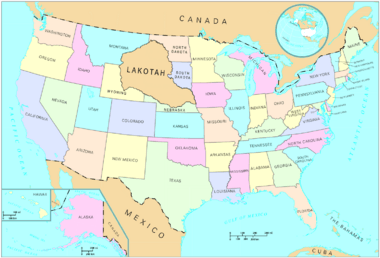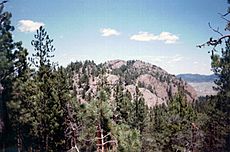Republic of Lakotah proposal facts for kids
The Republic of Lakotah is a suggested new country in North America. It is meant for the Lakota people. This idea was proposed in 2007 by an activist named Russell Means.
The suggested land for Lakotah would be completely surrounded by the United States. It would cover thousands of square miles. These areas are in North Dakota, South Dakota, Nebraska, Wyoming, and Montana. The proposed borders are based on an old agreement called the Treaty of Fort Laramie (1851). This treaty was signed between the U.S. government and the Lakota people.
Today, these lands include Indian reservations and other towns. It is important to know that none of the current Lakota tribal governments support this idea. They were not asked about the proposal.
Contents
Where Would Lakotah Be?
The suggested borders for Lakotah would follow natural features. The Yellowstone River would be to the north. The North Platte River would be to the south. The Missouri River would be to the east. An uneven line would mark the west.
These borders match those set by the Treaty of Fort Laramie (1851). This treaty described the land for the Lakota (also called Sioux or Dahcotah Nation). It started at the mouth of the White Earth River (North Dakota) on the Missouri River. Then it went southwest to the forks of the Platte River. It continued up the north fork of the Platte River to a place called Red Buts. From there, it followed the Black Hills mountains to the start of the Heart River (North Dakota). Then it went down the Heart River to its end, and down the Missouri River back to the start.
Why Some Lakota Want Independence
The group proposing Lakotah has several reasons for wanting to be independent. They say that the current system of reservations in the United States is unfair. They call it "colonial apartheid," which means unfair control and separation.
They claim that 150 years of U.S. control has caused many problems for the Lakota people. These problems include high unemployment, poverty, and illness. The group believes that becoming independent would help solve these issues. They also hope it would help bring back the Lakota language and culture. They say the United States has often broken its agreements with the Lakota.
Another big disagreement between the Lakota and the United States is about the Black Hills in South Dakota. These lands were part of the Lakota reservation. But the U.S. government took them without paying for them. This happened after the Treaty of Fort Laramie (1868) broke down. Gold was found there, leading to a gold rush.
In 1980, the highest court in the U.S., the Supreme Court, ruled on the case United States v. Sioux Nation of Indians. The court offered $105 million to eight Lakota tribes as payment. This money was for the land's value in 1877 plus interest. However, the court did not give the land back. The Lakota tribal governments have refused to accept this money. They want their land back, not just money.
The people who started Lakotah say their reasons come from a statement made in 1974. It was called the Oglala 1974 Declaration of Continuing Independence. This statement said:
The United States of America has continually violated the independent Native Peoples of this continent by Executive action, Legislative fiat and Judicial decision. By its actions, the U.S. has denied all Native people their International Treaty rights, Treaty lands and basic human rights of freedom and sovereignty. This same U.S. Government, which fought to throw off the yoke of oppression and gain its own independence, has now reversed its role and become the oppressor of sovereign Native people.
This means they believe the U.S. government has broken its promises. They say it has taken away the rights, lands, and freedom of Native peoples.
How Lakotah Would Be Governed
The proposed Republic of Lakotah would allow anyone living in its claimed territory to become a citizen. This would be open to people of all backgrounds. The group planned to create their own passports and driver's licenses.
They suggested that the nation would be a confederation. This means it would be a group of independent communities working together. It would focus on "individual liberty through community rule." There would be no nationwide taxes. However, individual communities could collect taxes if their people agreed. Russell Means, a leader of the movement, suggested that the nation should not use regular money. Instead, it should use a gold standard, where money's value is tied to gold.
Means said this government system comes from traditional Lakota ways. He explained that each community would be like a small state. These communities would then form the larger nation of Lakotah. Community leaders would be chosen informally by the community's elders.
Proposed Government Structure
On December 17, 2007, four activists called the Lakota Freedom Delegation went to Washington, D.C.. They delivered a statement saying they were "withdrawing from the treaties their ancestors signed with the U.S." They were "setting up their own independent nation." They said the U.S. government had failed to follow 33 treaties. These treaties promised land, health care, education, and other services. Their leader was Russell Means, a well-known member of the American Indian Movement.
The Lakota Freedom Delegation said they did not recognize the tribal governments that the United States Bureau of Indian Affairs recognized. They sometimes called these groups "stay-by-the-fort Indians." Also, the tribal governments, chosen by the Lakota people themselves, did not recognize the Republic of Lakotah.
The Republic of Lakotah announced that its temporary capital would be Porcupine, South Dakota. They hoped to move the main government offices near Rapid City, South Dakota later.
Before he passed away in 2012, Russell Means called himself the "chief facilitator" of a temporary government for the Republic of Lakotah. The four people who signed the letter to the U.S. government called themselves "Itacan of Lakota."
Means wanted the results of the 2008 Pine Ridge Reservation presidential election to be a vote on Lakota independence. He ran in that election but lost.
Claiming Independence
The four members of the provisional government were:
- Russell Means, "chief facilitator" (he passed away in 2012)
- Tegheya Kte (also known as Garry Rowland), "facilitator"
- Duane "Canupa Gluha Mani" Martin, "provisional government member"
- Phyllis Young, "provisional government member"
This "Freedom Delegation" went to Washington, D.C.. They told the State Department in a letter on December 17, 2007, that the Lakota were ending their treaties with the U.S. government. The letter said the Lakota were the "predecessor sovereign of Dakota Territory". This means they claimed to be the original rulers of the land. They said the U.S. had broken the treaties many times. The letter invited the U.S. government to talk with the new "Lakotah" nation. They also warned that if talks didn't start, "Lakotah" would begin to claim ownership of land deals within their claimed five-state area.
Legal Reasons for Independence
Those who support Lakotah say their claim to independence is legal. They believe it follows "natural, international, and United States law." They stress that they are not trying to break away from the U.S. (secession). Instead, they are withdrawing from treaties. They claim they have the right to withdraw from the Treaties of Fort Laramie. They base this on international agreements like the Vienna Convention on the Law of Treaties and the Declaration on the Rights of Indigenous Peoples.
They also point to a U.S. Supreme Court case from 1903, Lone Wolf v. Hitchcock. They say this case shows that the U.S. government does not always protect Native American rights well. Russell Means also mentioned the Enabling Act of 1889. This act had rules to protect Native American self-rule on lands where the Lakota lived. He said these rules have been ignored.
In a news release on January 15, 2008, the Republic of Lakotah suggested that their independence could be like a Compact of Free Association. This is an agreement some countries have with the U.S. They suggested their path to independence could be similar to that of the Philippines, Palau, the Federated States of Micronesia, or the Marshall Islands.
International Connections
The group has tried to get other countries to recognize Lakotah. They have contacted embassies from countries like Venezuela, Bolivia, Chile, and South Africa.
How People Reacted
Means and Mani claimed that about 13,000 Lakota people supported the Republic of Lakotah. They said this was 77% of the people on the Pine Ridge Indian Reservation. They also said the eight-member group that went to Washington, D.C., was just a small part of 77 tribal elders and activists involved.
U.S. Government Reaction
The United States Department of State sent questions about Lakotah to the United States Department of the Interior. This department oversees the Bureau of Indian Affairs (BIA). Gary Garrison from the BIA said that the group's withdrawal "doesn't mean anything." He added that these are "not legitimate tribal governments elected by the people." He warned that if they break laws, they could face arrest.
Russell Means said he did not expect the U.S. government to do anything. He believed they did not know how to react.
Lakota Tribes' Reaction
None of the existing Lakota tribal governments supported the proposed republic. They were not asked about the idea. A reporter named Bill Harlan said that most people he talked to had not heard about the declaration. Those who had heard did not want to talk about it publicly. The Rapid City Journal noted that no tribal presidents or top leaders from any Lakota Sioux tribes were part of the announcement.
Nanwica Kciji, an Oglala Lakota and former president of the Native American Journalists Association, disagreed with the 2007 declaration. He said that treaties are made between nations, not individuals. A scholar named Hiroshi Fukurai noted that the U.S., the UN, and other countries have mostly ignored the declaration of independence by the Republic of Lakotah.
Other Tribal Governments and Groups
Rodney Bordeaux, chairman of the Rosebud Sioux, said his tribe was not interested in joining the Republic of Lakotah. He said the Lakota Freedom Delegation never presented their plan to the tribal council. Bordeaux stated that the group does not represent the Lakota people or the elected tribal governments. However, he did say that Means "made some good points."
Joseph Brings Plenty, chairman of the Cheyenne River Lakota, agreed that the Lakota Freedom Delegation "are not representative of the nation I represent." He did not say if he agreed or disagreed with their goals. He noted that their actions did help raise awareness about the history of the Lakota people.
The Alaskan Independence Party supported the independent Lakota nation on December 21, 2007. They gave it "full recognition." Another group, the Second Vermont Republic, which wants Vermont to be independent, also announced its support. They encouraged other Native American groups to declare independence from the United States.
International Responses
In February 2008, the Lakotah Freedom Delegation gave a formal request for recognition of the Republic of Lakotah to several embassies. These included Russia, Serbia, Bolivia, Venezuela, the Republic of South Africa, Ireland, France, Nicaragua, East Timor, Chile, Turkey, India, Finland, Iceland and Uruguay.
According to Means, Venezuela's ambassador to the United States told the group that his country would not recognize Lakotah's independence. This was based on Venezuela's understanding of what the Lakotah Freedom Delegation was doing.
Lakotah Activities
On January 1, 2008, the republic announced it would file claims on all U.S. government-owned lands within their claimed borders. However, the first claims, in a county in South Dakota, were rejected.
In July 2008, Means announced that the Republic of Lakotah would create an all-Lakota "grand jury." This jury would investigate corruption by U.S. government officials on the seven reservations in the republic's claimed territory.
Means ran for president of the Oglala Lakota several times but was not successful. In the 2008 election, he lost.
See also
In Spanish: República de Lakota para niños




